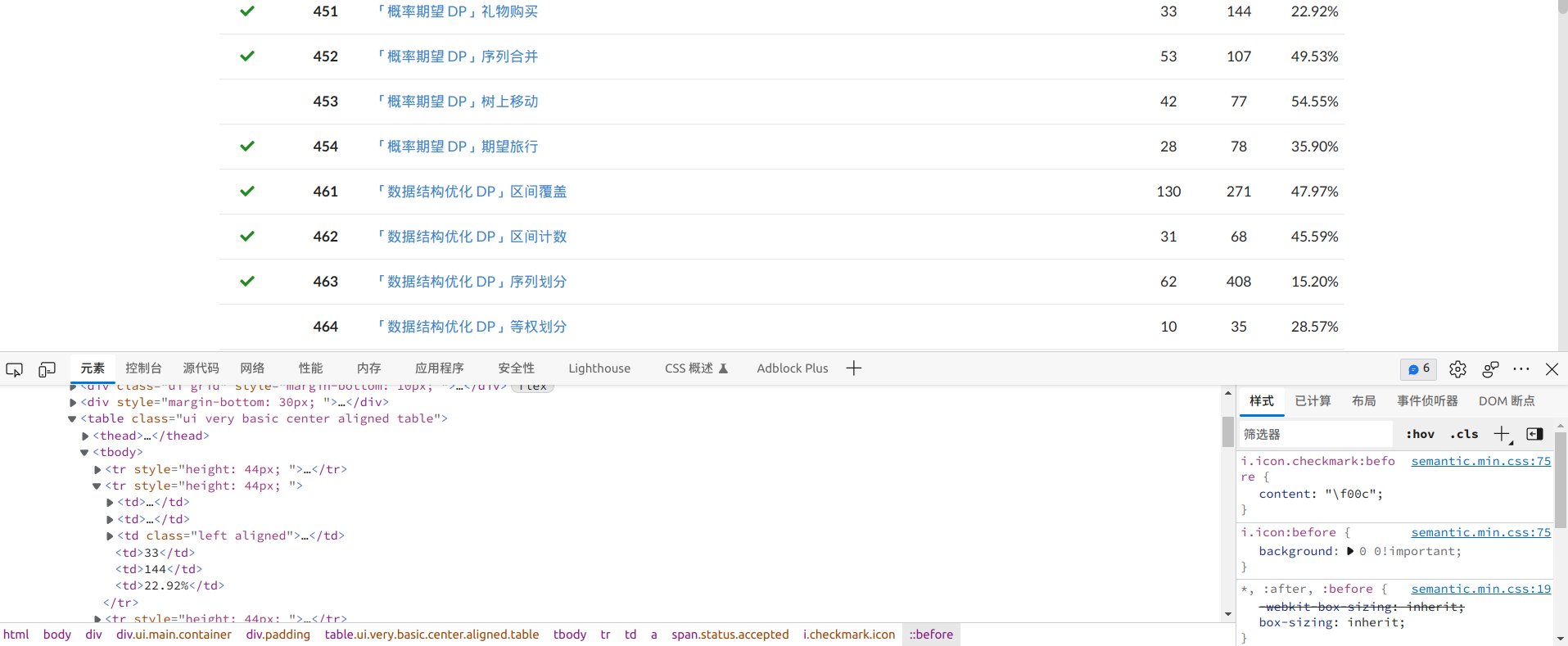写本文之前,我共有两百多道题目在校内 OJ 上通过,由于某些原因,想要保存这些代码,于是想到使用 Python 实现自动爬取代码。同时考虑到效率问题,决定使用 aiohttp 编写一个高性能异步爬虫。
实现目标分析
这个爬虫需要能够爬取所有的已通过题目的列表,并继续爬取这些已通过题目的代码,随后保存到文件中。
校内 OJ 基于 SYZOJ 搭建,该 OJ 的项目地址为 https://github.com/syzoj/syzoj,故接下来的代码都是基于其实现的。
由于这个 OJ 的外网域名的带宽很小,一个网页最坏情况下需要花费 2~3 秒的时间,所以必须采用异步实现。这里就使用 aiohttp 了。
获取 Cookie
由于直接从浏览器里获取的 Cookie 无法正常使用,传给服务器无法识别,猜测是编码问题,所以使用在爬虫运行时即时获取 Cookie 的办法。
分析 SYZOJ 的登陆页面源码,找到如下代码片段:
function login() {
password = md5($("#password").val() + "syzoj2_xxx");
$("#login").addClass("loading");
$.ajax({
url: "/api/login",
type: 'POST',
data: {
"username": $("#username").val(),
"password": password
},
async: true,
success: function(data) {
error_code = data.error_code;
switch (error_code) {
case 1001:
show_error("用户不存在");
break;
case 1002:
show_error("密码错误");
break;
case 1003:
show_error("您尚未设置密码,请通过下方「找回密码」来设置您的密码。");
break;
case 1:
success(data.session_id);
return;
default:
show_error("未知错误");
break;
}
$("#login").text("登录");
$("#login").removeClass("loading");
},
error: function(XMLHttpRequest, textStatus, errorThrown) {
alert(XMLHttpRequest.responseText);
show_error("未知错误");
$("#login").text("登录");
}
});
}
可以发现,SYZOJ 通过 /api/login 这个 Web API 发送请求获取 Cookie,使用 POST 方法,数据为 username 和 password,分别为用户名和密码加上 syzoj2_xxx 这个 salt 的 MD5,所以可以使用以下 Python 代码获取 Cookie
def get_password_md5(password: str) -> str:
password += "syzoj2_xxx"
return hashlib.md5(password.encode("utf-8")).hexdigest()
async def init_cookie(username: str, password: str) -> typing.Dict[str, str]:
async with aiohttp.ClientSession() as session:
# host 为 OJ 域名
async with session.post(
host + "/api/login",
data={
"username": username,
"password": get_password_md5(password),
},
) as response:
return response.cookies
随后就直接将 Cookie 传给 ClientSession:
async def main():
cookie = await init_cookie(username, password)
async with aiohttp.ClientSession(cookies=cookie) as session:
if len(cookie) == 0:
print("Failed to login.")
return
print("Succeeded to get cookie.")
# ...
获取通过题目列表
这里通过抓取题目页面来获取题目列表,如果一道题目已经通过,题目前面就会有一个绿色的勾,指向 AC 记录。

可以发现题目列表被放在整个页面的唯一一个 <table> 标签中,每一道题目被放在表格中的每一行 <tr> 中,具体结构如下:
<table class="ui very basic center aligned table">
<thead>
<!-- ... -->
</thead>
<tbody>
<tr style="height: 44px; ">
<!-- 如果没有提交记录,则接下来这个 td 为空 -->
<td>
<!-- 通过记录 -->
<a href="/submission/{id}">
<!-- AC 状态 -->
<span class="status accepted">
<i class="checkmark icon"></i>
</span>
</a>
</td>
<!-- 题目编号 -->
<td><b>1</b></td>
<td class="left aligned">
<!-- 题目名称和链接 -->
<a style="vertical-align: middle; " href="/problem/1">A + B Problem</a>
</td>
<!-- ... -->
</tr>
</tbody>
</table>
所以可以先用以下代码获取题目页面 HTML:
async def get_problem_page_content(
session: aiohttp.ClientSession, page_num: int
) -> str:
async with session.get(
host + "/problems", params={"page": str(page_num)}
) as response:
return await response.text()
然后使用 BeautifulSoup 处理 HTML:
def check_problem_accepted(tag: bs4.Tag) -> typing.Tuple[str, str] | None:
if tag.find("span", class_="status accepted") == None:
return None
problem_id = tag.b.string.strip()
# 获得保存文件名
problem_name = (
tag.find("a", style="vertical-align: middle; ")
.contents[0] # 如果某些题目要特殊权限,则会在后面在显示一个 <span>, 不可以直接用 tag.string
.strip()
.replace("/", "-") # / 不可以作为文件名的一部分
)
submission_url = tag.a["href"].strip()
return f"{problem_id}-{problem_name}", host + submission_url
def get_accepted_problems(content: str) -> typing.Dict[str, str]:
soup = bs4.BeautifulSoup(content, "html.parser")
problem_table = soup.find("tbody")
accepted_problems_dict = {}
# 处理每一行,如果是通过题目则加入字典
for row in problem_table.find_all("tr", recursive=False):
res = check_problem_accepted(row)
if res == None:
continue
accepted_problems_dict[res[0]] = res[1]
return accepted_problems_dict
异步爬取所有页面的题目:
async def process_problem_page(
session: aiohttp.ClientSession, page_num: int
) -> typing.Dict[str, str]:
content = await get_problem_page_content(session, page_num)
return get_accepted_problems(content)
async def get_problems(
session: aiohttp.ClientSession, page_nums: typing.Iterable[int]
) -> typing.Dict[str, str]:
problems_dict = {}
result = await asyncio.gather(
*[process_problem_page(session, num) for num in page_nums]
)
# 合并每个页面的题目
for page in result:
problems_dict.update(page)
return problems_dict
获取通过代码
有了提交记录 URL,就可以爬取代码了。
但是代码并不是直接放在 HTML 里传回来的,而是放在 Javascript 中再由浏览器处理得到的,具体可以查看网页源代码,发现以下两行:
const unformattedCode = "\u003Cspan class=\"pl-cp\"\u003E#include\u003C...";
const formattedCode = "\u003Cspan class=\"pl-cp\"\u003E#include\u003C...";
因为我的代码已经格式化过了,而且 OJ 默认的格式化风格和我不一样,所以我就抓取 unformattedCode 里的就可以了:
async def get_submission_content(session: aiohttp.ClientSession, url: str) -> str:
async with session.get(url) as response:
return await response.text()
async def get_code_html(session: aiohttp.ClientSession, url: str) -> str:
content = await get_submission_content(session, url)
# 截取 unformattedCode 里的内容
start = content.find('const unformattedCode = "') + len('const unformattedCode = "')
end = content.find("\";", start, content.find('const formattedCode = "', start))
# 把 \u003C 这样的 Unicode 转义字符转换为正常的字符
return re.sub(
r"(\\u[0-9a-fA-F])",
lambda match: match.group(1).encode("utf-8").decode("unicode-escape"),
content[start:end],
0,
re.M,
)
上面的代码判断会返回一个 HTML 字符串,含有非常多的 <span> 和 & 这样的东西,所以接下来的就是正常的 HTML 的处理了,把标签去掉,在把一些特殊符号转换回来就可以了:
async def get_code(session: aiohttp.ClientSession, url: str) -> str:
code = await get_code_html(session, url)
code = re.sub("</?[^>]+>", "", code, 0, re.M) # 去掉 HTML 标签
code = re.sub("<", "<", code, 0, re.M)
code = re.sub(">", ">", code, 0, re.M)
code = re.sub("&", "&", code, 0, re.M)
code = re.sub(""", '"', code, 0, re.M)
code = re.sub("'", "'", code, 0, re.M)
code = re.sub("'", "'", code, 0, re.M)
return code
async def scrape_code(session: aiohttp.ClientSession, problem: str, url: str) -> None:
try:
code = await get_code(session, url)
# 写入代码到文件
with open(problem + ".cpp", "w") as writer:
writer.write(code)
except Exception as e:
print(f"Failed to scrape {problem} from {url}: {e}")
完善主程序
async def main() -> None:
with open("passwd.txt") as f:
username = f.readline().strip()
password = f.readline().strip()
cookie = await init_cookie(username, password)
async with aiohttp.ClientSession(cookies=cookie) as session:
if len(cookie) == 0:
print("Failed to login.")
return
print("Succeeded to get cookie.")
# 指定爬取的题目页面编号
problems = await get_problems(session, range(1, 15))
print(f"Succeeded to get the problem list. {len(problems)} problems in total.")
# 需要将这些协程加入 Eventloop 实现异步爬取
await asyncio.gather(
*[scrape_code(session, problem, url) for problem, url in problems.items()]
)
print("All tasks have finished.")
if __name__ == "__main__":
asyncio.run(main())
完整代码见 GitHub。
测试
使用同学的帐号进行测试,爬取 465 道题目仅需 27 秒:

如果使用同步爬虫,则需要 1 分 18 秒,效率提升还是很明显的。
性能提升
如果网络延迟较低,字符串相关的处理可能会成为性能瓶颈,可以考虑使用多线程/多进程进行优化。具体也没有我也尝试过,因为大多数情况下网络延迟还是比较严重的,所以在其他方面做优化不一定有用。大家可以自己实现。